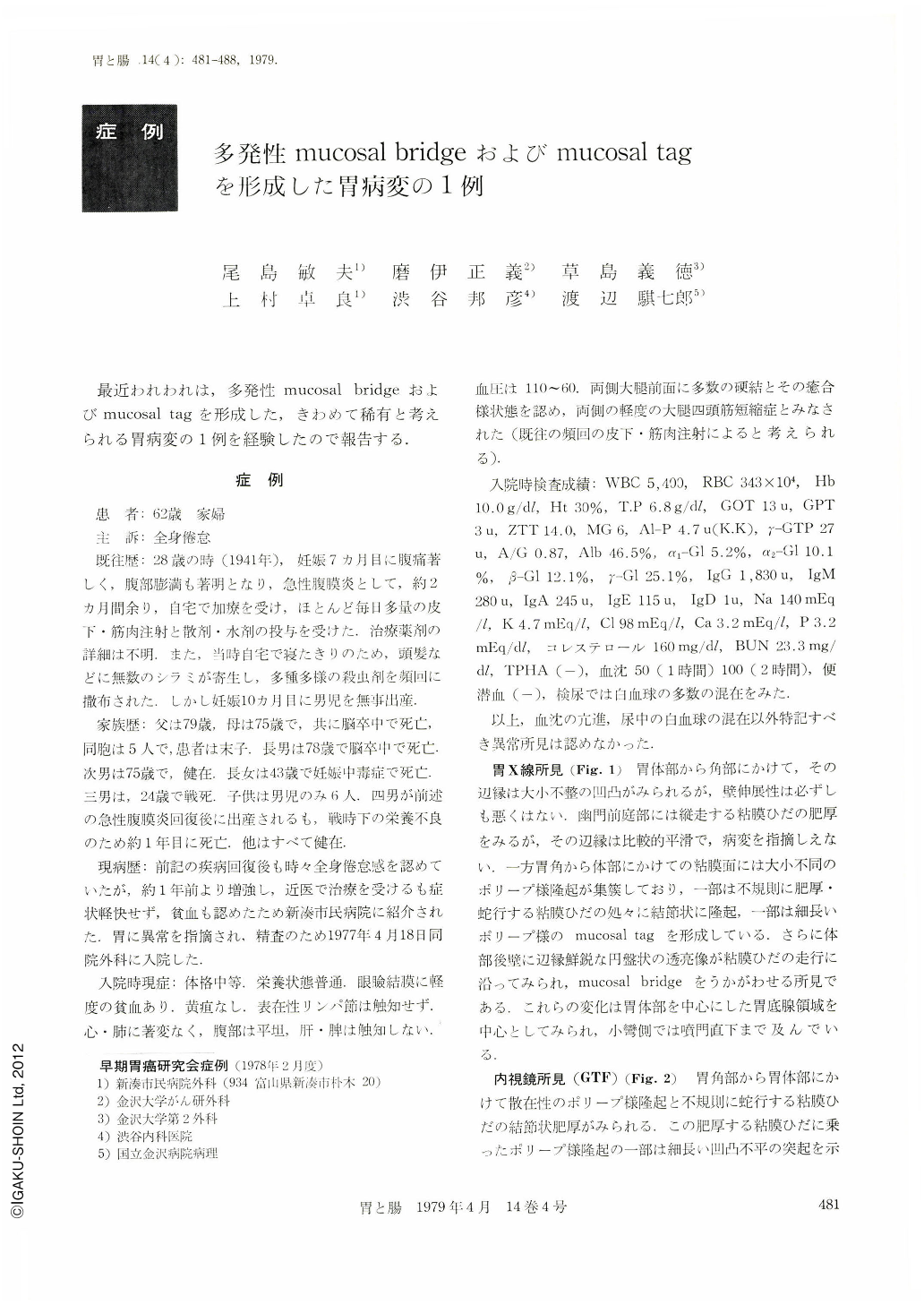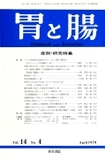Japanese
English
- 有料閲覧
- Abstract 文献概要
- 1ページ目 Look Inside
最近われわれは,多発性mucosal bridgeおよびmucosal tagを形成した,きわめて稀有と考えられる胃病変の1例を経験したので報告する.
症例
患 者:62歳 家婦
主 訴:全身倦怠
既往歴:28歳の時(1941年),妊娠7カ月目に腹痛著しく,腹部膨満も著明となり,急性腹膜炎として,約2カ月間余り,自宅で加療を受け,ほとんど毎日多量の皮下・筋肉注射と散剤・水剤の投与を受けた.治療薬剤の詳細は不明.また,当時自宅で寝たきりのため,頭髪などに無数のシラミが寄生し,多種多様の殺虫剤を頻回に撒布された.しかし妊娠10カ月目に男児を無事出産.
A 62-year-old housewife was admitted to the Shinminato City Hospital on April 18, 1977, with a complaint of general fatigue. She had noticed it about one year before admission and the symptom gradually became worse. Family history was non-contributory. Past history revealed that she had had a severe acute peritonitis about 36 years before (she was then 28 years old, 1941) in the seventh month of the fourth pregnancy, and had been treated for more than two months. Details of the symptoms, the course and the treatment were obscure, and the cause was also unknown.
Physical and laboratory examinations on admission disclosed no remarkable changes except high erythrocyte sedimentation rate. Roentgenographic and endoscopic examinations showed mucosal bridges and mucosal tags in the stomach. There were no particular abnormalities in the barium enema studies. Because of massive bleeding after the transendoscopic polypectomy of the gastric lesion, partial gastrectomy was emergently carried out. Laparotomy showed no remarkable changes in the abdominal cavity. The postoperative course was uneventful and she has a good recovery.
Macroscopically, irregularly elevated mucosal folds were seen mainly on the anterior and posterior walls of the body in the resected stomach. Eight mucosal bridges were observed on the body, mostly running in lines of the tag-like elevated mucosal folds, and five typical mucosal tags were also seen mostly on the elevated mucosal folds. Partially there was a thinned mucosal portion in the raised tag-like mucosa. The largest mucosal bridge measured about 3 cm in diameter, and the tallest mucosal tag was about 3 cm in height. There was no active ulcer in the entire resected stomach except polypectomized sites. Ulcer scars and adhesive mucosal folds were seen on the body. The mucosal bridges and tags were thoroughly covered by the mucosa.
Microscopically, there were little hypertrophy and atrophy in the mucosa, and nearly normal epithelium was well preserved on the body and the pylorus. Intestinal metaplasia of the mucosa was not at all detected. The inflammatory cell infiltration of the gastric wall was minimal. Mucosal bridges and tags consisted of the mucosa, muscularis mucosa and sub-mucosa. The muscularis mucosa was mostly thickened here and the submucosal fibrosis was fairly seen. In the marginal skirts of the bridges, tags, and tag-like elevated mucosal folds were seen multiple and superficial ulcer scars widely distributed (healed Ul Ⅱ~Ⅲ). The floor of the bridge disclosed the same ulcer scars. Fibrosis of the submucosa at the scarred areas was scarce. The formation of the mucosal bridges and tags of this case might not be focused only on the adhesion of inflammatory polyposis or the communication of the undermining ulcer as was stressed in the colonic cases. Besides, the secondary changes of the markedly elevated mucosal folds due to a long term existence of the widely-spread, multiple ulcer scars might also have participated in the formation of this gastric lesion. The multiple active ulcers were thought to have occurred 36 years before.

Copyright © 1979, Igaku-Shoin Ltd. All rights reserved.


